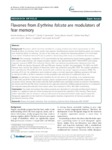Por favor, use este identificador para citar o enlazar este ítem:
http://www.alice.cnptia.embrapa.br/alice/handle/doc/999163| Título: | Flavones from Erythrina falcata are modulators of fear memory. |
| Autor: | OLIVEIRA, D. R. de  ZAMBERLAM, C. R.   GAIARDO, R. B.   REGO, G. M.   CERUTTI, J. M.   CAVALHEIRO, A. J.   CERUTTI, S. M.   |
| Afiliación: | Daniela Rodrigues de Oliveira, Universidade Federal de Sao Paulo; Cláudia R. Zamberlam, Universidade Federal de Sao Paulo; Renan Barreta Gaiardo, Universidade Federal de Sao Paulo; GIZELDA MAIA REGO, CNPF; Janete M. Cerutti, Universidade Federal de Sao Paulo; Alberto J. Cavalheiro, UNESP; Suzete M. Cerutti, Universidade Federal de Sao Paulo. |
| Año: | 2014 |
| Referencia: | BMC Complementary and Alternative Medicine, v. 14, n. 288, p. 1-17, Aug. 2014. |
| Descripción: | Background: Flavonoids, which have been identified in a variety of plants, have been demonstrated to elicit beneficial effects on memory. Some studies have reported that flavonoids derived from Erythrina plants can provide such beneficial effects on memory. The aim of this study was to identify the flavonoids present in the stem bark crude extract of Erythrina falcata (CE) and to perform a bioactivity-guided study on conditioned fear memory. Methods: The secondary metabolites of CE were identified by high performance liquid chromatography combined with a diode array detector, electrospray ionization tandem mass spectrometry (HPLC-DAD-ESI/MSn) and nuclear magnetic resonance (NMR). The buthanolic fraction (BuF) was obtained by partitioning. Subfractions from BuF (BuF1 ? BuF6) and fraction flavonoidic (FfA and FfB) were obtained by flash chromatography. The BuF3 and BuF4 fractions were used for the isolation of flavonoids, which was performed using HPLC-PAD. The isolated substances were quantified by HPLC-DAD and their structures were confirmed by nuclear magnetic resonance (NMR). The activities of CE and the subfractions were monitored using a one-trial, step-down inhibitory avoidance (IA) task to identify the effects of these substances on the acquisition and extinction of conditioned fear in rats. Results: Six subclasses of flavonoids were identified for the first time in CE. According to our behavioral data, CE, BuF, BuF3 and BuF4, the flavonoidic fractions, vitexin, isovitexin and 6-C-glycoside-diosmetin improved the acquisition of fear memory. Rats treated with BuF, BuF3 and BuF4 were particularly resistant to extinction. Nevertheless, rats treated with FfA and FfB, vitexin, isovitexin and 6-C-glycoside-diosmetin exhibited gradual reduction in conditioned fear response during the extinction retest session, which was measured at 48 to 480 h after conditioning. Conclusions: Our results demonstrate that vitexin, isovitexin and diosmetin-6-C-glucoside and flavonoidic fractions resulted in a significant retention of fear memory but did not prevent the extinction of fear memory. These results further substantiate that the treatment with pure flavonoids or flavanoid-rich fractions might represent potential therapeutic approaches for the treatment of neurocognitive disorders, improvement of memory acquisition and spontaneous recovery of fear. |
| Thesagro: | Erythrina Falcata |
| NAL Thesaurus: | extinction |
| Palabras clave: | Flavona Uso terapêutico Memória Medo condicionado Flavone Acquisition Fear conditioning |
| DOI: | 10.1186/1472-6882-14-288 |
| Tipo de Material: | Artigo de periódico |
| Acceso: | openAccess |
| Aparece en las colecciones: | Artigo em periódico indexado (CNPF)  |
Ficheros en este ítem:
| Fichero | Descripción | Tamaño | Formato | |
|---|---|---|---|---|
| 2014APIGizeldaFlavonesErythrina.pdf | 1.65 MB | Adobe PDF |  Visualizar/Abrir |









